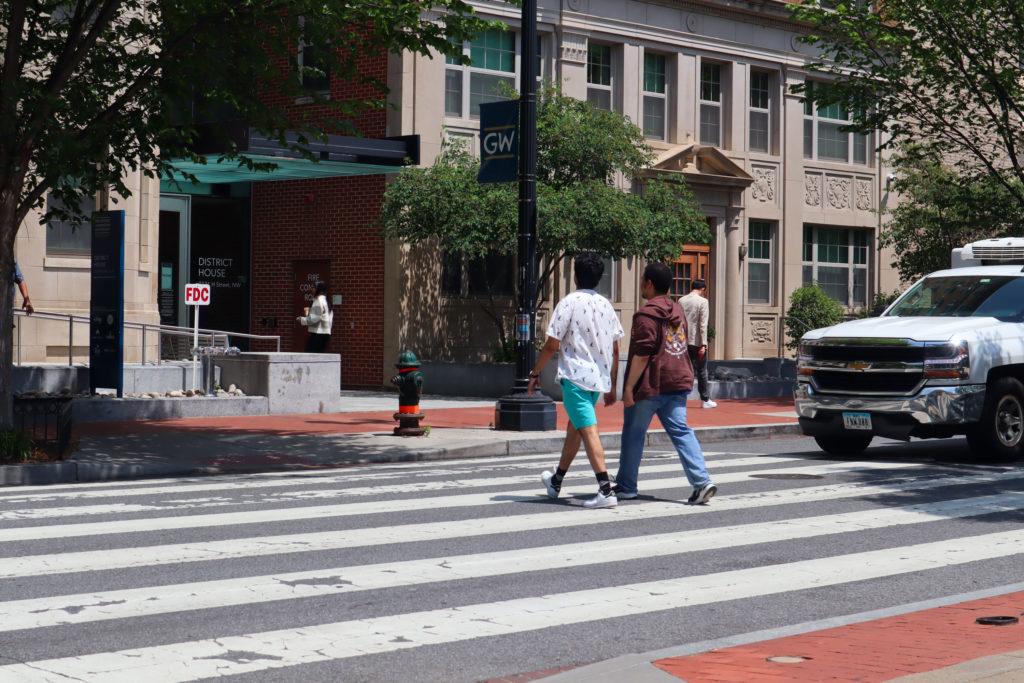Editor’s note: The Hatchet retracted a previous story about the H Street project earlier this month.
An undergraduate research group has petitioned the University to make a portion of H Street between 21st and 22nd streets more sustainable and pedestrian friendly since the beginning of the spring semester in an effort to turn a “really unsafe” street into a “major campus space.”
The GW Undergraduate Sustainability Research Fellows, a group of five students conducting a yearlong sustainability research project with advice from officials in the GW Office of Sustainability, are proposing to redesign H Street between Kogan Plaza and the University Student Center as a woonerf, a European street concept repurposing streets away from motor vehicle use and allowing for more greenery and open space. The student researchers said they received responses on a survey they released last month that indicate community members are concerned with pedestrian safety on the street and want to increase the road’s sustainability by adding greenery — feedback they said will help convince the Board of Trustees to approve about $4 million in funding for redesigning the street this month.
The fellows said preliminary results of the survey show respondents care most about pedestrian safety and plants and native vegetation on the street, followed by tables, study space and community and meeting areas. Initial results of the survey also show a motor vehicle has hit or nearly struck almost 70 percent of respondents on the street, with 53 percent saying they have seen or heard of a motor vehicle hitting someone.
Mia Rosenblatt, one of the sustainability fellows and a senior majoring in environmental studies, said the group organized two focus groups of approximately 10 students in the fall and found students want to see city officials redesign H Street due to concerns about motor vehicles striking them. She said improving traffic safety is the “main driver” of the fellows’ proposal to turn the street into a woonerf and that the fellows can add sustainability features like rain gardens alongside the redesign.
“Every single person I’ve talked to has been like, ‘Oh, that’s such a good idea, it’s so dangerous, I don’t feel safe,’” Rosenblatt said.
Metropolitan Police Department officials reported more than 90 traffic accidents on H Street between 20th and 23rd streets from 2010 to 2020. District Department of Transportation officials reported 19 traffic-related pedestrian deaths last year in the District, with six so far this year as of Sunday.
Matthew Hernandez, one of the sustainability fellows and a senior studying public policy, said the woonerf street design is a “middle ground” between the current design of H Street and completely closing the street off to motor vehicles, which he said city officials “wouldn’t ever think” about doing.
“It’s more of a community space,” Hernandez said. “It’s not just for cars, people can walk freely in it.”
Hernandez said there have been proposals in the past to redesign H Street, including in October 2021 when the architectural firm Cooper Robertson recommended a “very similar” redesign to the street compared to the four mockups the fellows are considering.
DDOT officials gather community feedback for a conceptual redesign and receive permits for a detailed redesign from other agencies like the D.C. Office of Planning before redesigning streets, according to DDOT’s project development manual.
“All it is just a street for cars, that’s all it is,” Hernandez said. “All it does is just emit CO2 and pedestrians are almost hit.”
Hagan Leeds Richman, one of the sustainability fellows and a senior majoring in international affairs, said converting H Street into a woonerf would create more of an overall “campus” feel. He said the fellows have tabled in Kogan and University Yard for the April Eco-Bash event, where campus and local environmental organizations set up booths and engaged with community members, to gain support for redesigning the street before they ask the Board to provide funding this month.
“There’s already kind of a buzz and some pressure on these people to show students really want this, the community really wants this, we should approve it and make it happen,” Richman said.
Students said they want to see officials transform H Street to prioritize pedestrian safety and increase campus greenery.
David Bisker, a sophomore majoring in international affairs, said redesigning H Street is “long overdue” and that he “constantly” sees the “conflict” between motor vehicles and pedestrians on the street.
“I’m surprised that a University with as much claim to being environmental and cognizant of urban inequalities wouldn’t be more aware of this earlier,” Bisker said.
Bisker said the lack of speed bumps and the asphalt material on H Street “encourages” motor vehicles to go fast. As he was speaking, a truck traveled quickly through the street.
“That car over there, if a little person was crossing they would barrel into them,” Bisker said. “There’s not enough time to react.”
Emily Lamb, a senior majoring in political science, said there is a “demand” for green space at GW, especially when the sun comes out.
“I think that’s something about GW is that it’s kind of an individualistic space, and developing more of a campus structure, I think, would be beneficial for everyone,” Lamb said.
University officials demolished the former Nashman Center for Civic Engagement and Public Service building in October 2021 on the corner of I and 22nd streets and added green space, following some locals criticizing the proposal due to the building’s historic value after it was built in 1886. Officials also tore down the more than a century-old Staughton Hall across from Duquès Hall in May 2022 and replaced it with green space while University officials created a “redevelopment” plan, according to a University spokesperson in a January 2022 email.
Morgan Kogan, a sophomore majoring in international affairs, said motor vehicle drivers don’t “react accordingly” on H Street when they realize they are driving through a college campus.
“It’s probably easier to get the drivers to change than it is to get the students to change how they interact with their campus,” Kogan said.








